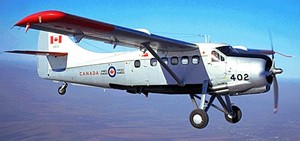

|
| | HOME | ART's GALLERY | AIRCRAFT | | | GAZA STRIP | YEMEN | CONGO | NEW GUINEA | INDIA/PAKISTAN | KOREAN AIRLIFT | TANZANIA |
|
AIRCRAFT - Introduction Caribou Otter Twin Otter Dakota North Star Flying Boxcar Yukon Hercules Sikorsky S-55 |

AIRCRAFTde Havilland DHC-3 (CC-123) OtterMost of the following information is based on the book "De Havilland Canada DHC-3 Otter: A History" by Karl E. Hayes. For more information on this excellent Otter resource, contact Karl Hayes via the Old Wings web site. GazaSeven DHC-3 (CC-123) Otter rotated through 115 ATU. From Hayes: The task of transporting the first four Otters for 115 ATU to Egypt was given to the aircraft carrier 'HMCS Magnificent', then in the final weeks of its service with the Royal Canadian Navy. It was about to be replaced by the 'Bonaventure', which was then being completed in Belfast. In October 1956 the 'Magnificent' sailed to Belfast carrying stores and equipment to be transferred to the 'Bonaventure'. It was then supposed to sail to Glasgow, Scotland to collect 50 Sabre Mark Vs for the RCAF, but was ordered instead to return as fast as possible to its home port of Halifax, Nova Scotia to load supplies for the United Nations mission. At Halifax, the 'Magnificent' was loaded with one hundred tons of supplies, 233 vehicles, one HO4S helicopter and the four Otters (3675, 3743, 3744 and 3745), which had been flown to Halifax. The 'Magnificent' sailed from Halifax on 29th December 1956 and docked at Port Said, Egypt in mid January 1957. On 13th January, maintenance personnel started assembling the Otters, which had been carried as cargo below deck. On 18th January the four Otters flew off the carrier to their new base at El Arish. The Otters took off from the flight deck while the carrier rode at Anchor. One almost didn't make it. Immediately after becoming airborne, the right wing dropped and scraped along the deck before the Otter struggled off the end of the carrier. The damage was repaired on arrival at El Arish. Ironically, the last fixed wing aircraft to take off from 'HMCS Magnificent', after thousands of naval aircraft sorties, were the four RCAF Otters! The 'Magnificent' departed Port Said on 20th January '57, arriving at Glasgow via Naples on 2nd February, where the 50 Sabres were at last loaded on board. Many of the crew and the helicopter were transferred to the 'Bonaventure' and the 'Magnificent' returned to Halifax with the Sabres. That was its last mission and the carrier was subsequently scrapped. Meanwhile, the four Otters had arrived at El Arish where they were joined by two RCAF Dakotas and 115 Air Transport Unit became operational. The Otters were used for transport, communications and general utility tasks, as well as for observing and patrolling border areas, particularly the 59 kilometre Demarcation Line in the Gaza Strip and the 209 kilometre frontier between the United Arab Republic and Israel, and also observing shipping going through the Strait of Tiran at the southern tip of the Sinai Peninsula. The first operational mission with an Otter took place on 22nd January '57, a road recce in the El Arish area. In an Air Transport Command briefing at Trenton in November 1966, the Unit's operational scenario was reviewed, which describes the work these Otters performed: “The reconnaissance task principally involves flights along the Egyptian side of the International frontier between Israel and Egypt, which extends south from the south-east corner of the Gaza Strip, a point commonly referred to as Rafah Corner, to the top of the Gulf of Aqaba and the UN outpost as Ras Al Naqb. Less frequent recce flights are carried out along the still-disputed Armistice Demarcation Line marking the boundary between the Gaza Strip and Israel and along the Gulf of Aqaba to the UN outpost at Sharm El Sheikh at the top of the Red Sea and the southern extremity of the Sinai Peninsula”. “The Armistice Demarcation Line (ADL) and the first forty miles of the International Frontier (IF) lies in relatively flat, low-lying land covered only with very sparse vegetation and nearly all of that on the Israeli side. The area is for the most part an area of shifting sand dunes. The ADL is well marked by a road and frequent UN observation posts. The first part of the IF is marked by a road and along the former Canadian sector by forty gallon drums mounted on cement pillars and painted blue and white. The remaining odd ninety miles to the end of the IF at the top of the Gulf of Aqaba is rough and forbidding, marked with frequent rocky hills and mountains rising as high as 2,800 feet and with only sparse vegetation and the odd small oasis. Generally the terrain is favourable to air reconnaissance. However, this is true only of the daylight hours. During the hours of darkness, air reconnaissance is not available. The weather is nearly always suitable for visual flight. There are however periods of early morning fog and sandstorm activity which at times restrict and occasionally cancel out flying activity”. 115 ATU's Otter operations continued until early January 1967. The first four Otters delivered HMCS Magnificent were:

Three additional Otters rotated into theatre:
New GuineaTwo Otters were assigned to 116 ATU in New Guinea:
India/PakistanThree Otters were assigned to 117 ATU in India/Pakistan:
An additional three Otters (9404 cn 361, 9415 cn 393, and 9426 cn 409) were assigned as spares but remained in Canada.
|
| Click here to Email |